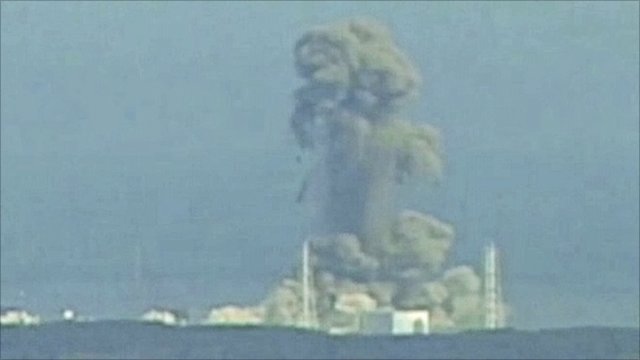 A second explosion has hit a Japanese nuclear plant that was damaged in Friday's earthquake, but officials said the reactor core was still intact.
A second explosion has hit a Japanese nuclear plant that was damaged in Friday's earthquake, but officials said the reactor core was still intact.
A huge column of smoke billowed from Fukushima Daiichi's reactor 3, two days after a blast hit reactor 1.
The latest explosion, said to have been caused by a hydrogen build-up, injured 11 people, one of them seriously.
Soon afterwards, the government said a third reactor at the plant had lost its cooling system.
Water levels were now falling at reactor 2, which is to be doused with sea water, said government spokesman Yukio Edano.
A similar cooling system breakdown preceded the explosions at reactors 1 and 3.
Evacuations
Japanese officials are playing down any health risk, but the US said it had moved one of its aircraft carriers from the area after detecting low-level radiation 100 miles (160km) offshore.
Technicians have been battling to cool reactors at the Fukushima Daiichi plant since Friday, following the quake and tsunami.
In other developments:
Two thousand bodies have been found on the shores of Miyagi prefecture, Japanese media are reporting
The government said it would pump 15 trillion yen ($182bn; £113bn) into the economy to prop up markets, but the Nikkei slumped more than 6%
Prime Minister Naoto Kan postponed planned rolling powercuts, saying they may not be needed if householders could conserve energy
The BBC's Rachel Harvey in the port town of Minamisanriku says everything has been flattened until about 2km inland.
It looks unlikely that many survivors will be found, she adds.
Japanese police have so far confirmed 1,597 deaths, but the final toll is expected to be much higher.
Tens of thousands of people have been evacuated from the area around Fukushima Daiichi plant.
At least 22 people were said to be undergoing treatment for radiation exposure.
Powerful aftershocks
The government said radiation levels were below legal limits after Monday's explosion. Tokyo Electric Power, which runs the plant, said the reactor's containment vessel had resisted the impact.
The operators say the thick containment walls shielding the reactor cores have so far remained intact.
Even if the fuel rods do go into meltdown there should not be a release of radioactive clouds, they say.
The BBC's Chris Hogg in Tokyo says radiation has been detected outside the plant, but at low concentrations.
At one point it rose to a level similar to that one is exposed to during an X-ray, our correspondent says.
Experts say a disaster on the scale of Chernobyl in the 1980s is highly unlikely because the reactors are built to a much higher standard and have much more rigorous safety measures.
Earlier, the prime minister said the situation at the nuclear plant was alarming, and the earthquake had thrown Japan into "the most severe crisis since World War II".
The government advised people not to go to work or school on Monday because the transport network would not be able to cope with demand.
The capital Tokyo is also still experiencing regular aftershocks, amid warnings that another powerful earthquake is likely to strike very soon.
Meanwhile, tens of thousands of relief workers, soldiers and police have been deployed to the disaster zone.
Preliminary estimates put repair costs from the earthquake and tsunami in the tens of billions of dollars.
The disaster is a huge blow for the Japanese economy (the world's third largest), which has been ailing for two decades.
The Foreign Office has updated its travel advice to warn against all non-essential travel to Tokyo and north-eastern Japan.
British nationals and friends and relatives of those in Japan can contact the Foreign Office on +44(0) 20 7008 0000.



